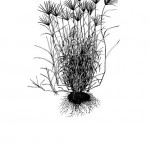Rhodesgrass
Chloris gayana
Poaceae
Description
This species should not be confused with Chloris pluriflora which is a synonym for Trichloris pluriflora, Multi Flowered Rhodesgrass as both are referred to as “Rhodesgrass”. This species is native to Africa but has been extensively used for its forage in warm and dry areas. Stems grow from a leafy base to reach over a meter and sometimes as high as three meters tall. This is an erect bunchgrass, but it often has long stolons that root at the leafy nodes. The culms are somewhat wiry and flattened with dark nodes. Rivaling the stem height, its roots can reach 167 inches or 4.24 meters deep, enabling it to withstand drought. Sheaths are about half the length of the internode with pilose (I.e., long, soft, and straight hairs) adjacent to the ligules. Its leaves can be 15 to 35 cm long by 2 to 10 mm wide, gradually tapering to a sharp point. The inflorescence has ten or more terminal spikes each 4-15 cm. Each spike has about ten spikelets per cm of rachis; they are pale to tawny in color and imbricate (overlap). The spikelets are borne to the base of the spike and have short awns (up to 6.5 mm). One of Rhodegrass’ unique features is seeds that germinate in one to seven days. Its very desirable traits: low rainfall required, ability to tolerate poor soils and salinity, and fast growth, which make it a great candidate for poor farmers working on poor land and has facilitated naturalization. It can form almost pure stands pushing out native species. Rhodesgrass is an essential perennial, warm season, introduced grass for forage production in South Texas where it has been introduced as a pasture grass. It provides fair grazing for livestock and wildlife with particular importance as forage grass in hot, dry areas.Habitat
Grows on loamy bottomlands and is managed as a cultivated forage grass. Has escaped along many roadsides. Native to tropic and temperate regions worldwide but may have originally come from tropical East Africa. Again, its tolerance to moderately saline and alkaline soils coupled with its low rainfall requirement means it can survive in dry climates.Images
Plant Characteristics
Duration: Perennial
Stem Texture: Hairless/Smooth
Growth Habit: Bunch grass, Grasses
Season: Warm
Distribution
 : 02 - Gulf Prairies and Marshes, 03 - Post Oak Savannah, 04 - Blackland Prairies, 06 - South Texas Plains
: 02 - Gulf Prairies and Marshes, 03 - Post Oak Savannah, 04 - Blackland Prairies, 06 - South Texas Plains
Distributions
Distribution refers to the ecological region in Texas that a plant has been found. You can also view a clickable map.
Book: Know Your Grasses (B-182)
Collection: Grasses


